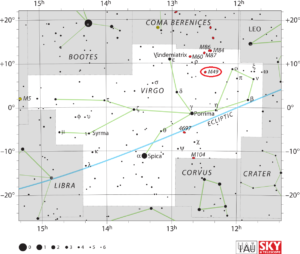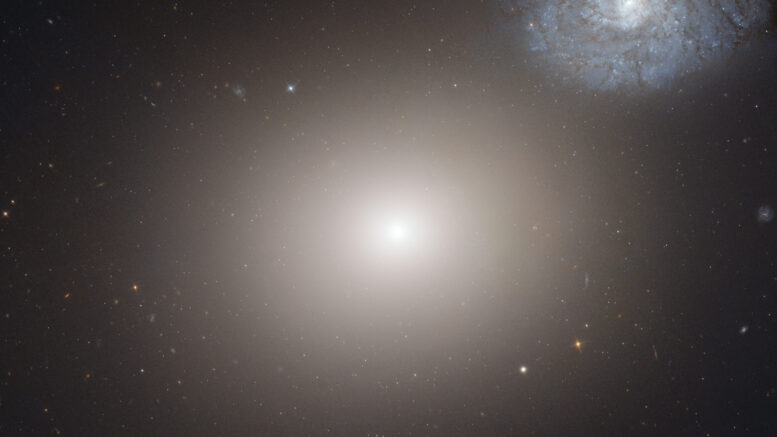Messier 60 is a giant elliptical galaxy located in the constellation Virgo. The galaxy has an apparent magnitude of 9.8 and lies at an approximate distance of 55 million light years from Earth. It has the designation NGC 4649 in the New General Catalogue.
| Description | |
| Visible From Pacific Northwest | January to June |
| Best Time To Observe | February, March, and April |
| Minimum Size Of Viewing Device | Small Telescopes |
| Object Type | Elliptical Galaxy |
| Designations | Messier 60, M60, NGC 4649, PGC 42831, UGC 7898, GC 3182, Arp 116, 2E 1241.1+1149, 2MASX J12434000+1133093, MCG+02-33-002, RBS 1150, RX J1243.6+1133, VCC 1978, VV 206a, Z 1241.1+1150 |
| Right Ascension | 12h 43m 39.6s |
| Declination | +11°33’09” |
| Constellation | Virgo |
| Number Of Stars | 400 billion |
| Apparent magnitude | -22.3 |
| Apparent dimensions | 7′.4 x 6′.0 |
| Object Radius | 60,000 light years |
| Distance From Earth | 55 million light years |
History
Messier 60 and its close neighbour Messier 59 were discovered by the German astronomer Johann Gottfried Koehler in on April 11, 1779. Koehler was observing a comet when he discovered the galaxies. He noted, “Two very small nebulae, hardly visible in a 3-foot telescope: The one above the other.”
Italian astronomer Barnaba Oriani independently discovered M60 a day after Koehler did, but he did not spot the neighbouring M59. He described M60 as “very pale and looking exactly like the comet [1779 Bode, C/1779 A1].”
Charles Messier discovered the two galaxies independently a few days after Koehler and included them in his catalogue along with the nearby M58 on April 15, 1779.
John Herschel catalogued M60 as h 1408 and NGC 4647 as h 1405, describing the larger galaxy as “bright; round; brighter toward the middle. The brighter of a fine pair, the other [NGC 4647] is very faint; extended in position angle 30deg north preceding [NW]; 2 1/2′ distant. ” He later added M60 to the General Catalogue as GC 3182.
A supernova was observed in M60 in 2004. Designated SN 2004W, it was classified as a subtype of Ia. When it was detected, the supernova had already faded to magnitude 18.8. It had remained undetected for months because M60 was near its solar conjunction at the time.
Locating M60 In The Sky
Messier 60 is the easternmost Messier galaxy in the Virgo Cluster. It is located 25 arc minutes away from M59 and can be seen in the same field of view at lower magnifications. The galaxy can be found about 4.5 degrees along the line from Vindemiatrix in Virgo to Denebola in Leo.

Viewing M60
In amateur telescopes, observers can only see the galaxy’s bright central region, which is about 4 by 3 arc minutes in diameter. 4-inch telescopes reveal the nearby spiral galaxy NGC 4647, while significantly larger instruments show many faint globular clusters in M60. The best time of year to observe the galaxy is during the months of March, April and May.
Photographing M60
Although Messier 60 is not necessarily that interesting to image, there are dozens of other galaxies visible in the same frame as elliptical galaxy. An amazing spring galaxy, Messier 60 will require several hours of imaging with accurate autoguiding. There are a plethora of options for use, which have been blogged by several astrophotographers and astrobin can provide a great option for viewing how others with similar gear have handled imaging M60.
https://www.galactic-hunter.com/post/m59-m60
Sources And Further Reading
Descriptions of all of Messier Objects can be found here.
https://www.nasa.gov/feature/goddard/2017/messier-60
https://www.messier.seds.org/m/m060.html
https://freestarcharts.com/messier-60

Be the first to comment on "Messier 60"